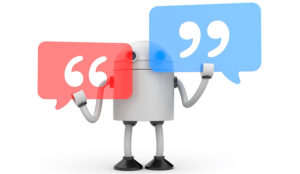Our panel highlight the mistakes you should be avoiding in order to succeed using webchat.
Mistake #1: Overusing proactive, pop-up webchat
While a bright or invasive chat pop-up will get noticed, it may soon annoy the browser.
Consider limiting the use of proactive chat (offering chat before being requested) to specific pages where it would add value to the customer and prevent contact via another channel.
For example, if the customer has been on the basket or checkout page for longer than the average browse time, you could proactively offer the help which could lead to a completed purchase.
Mistake #2: Overlooking the need for skills-based routing and journey planning
Webchats that receive inadequate answers increase customer frustration. Therefore, contact centres need to route the customer’s chat to the correct agent.
Their journey needs to be planned as carefully as you would for phone calls, in order to ensure that the agent answering has the highest chance of success and the customer has the greatest possibility of resolving the query in the first contact.
Mistake #3: Failing to prioritise the customers with the most pressing issues
Not all webchat conversations are of equal priority. Customers on certain pages may make critical decisions to buy or not; or similarly they may decide to continue searching or leave the site.
Converting or retaining customers at these times is very important; priority pages should be added to an accelerated route or journey map so that the customer receives the most prompt and specific attention possible.
Mistake #4: Not clearly indicating when your agents are on- or off-line
If you are currently failing to make it clear when webchat is not available, you could consider providing a signpost for when the service is offered and offer an alternative contact such as an eForm or email for a later response.
When agents are online, increase the personalisation of the experience by indicating the likely queue time or providing an activity indicator such as ‘agent typing’.
Testing the interaction yourself is a great way to experience how it works and understand what you are asking from the customer throughout the process.

Richard Farrell
Mistake #5: Forgetting to give the customer a copy of the transcript
It is helpful to offer the chat transcript to the customer at the end of the chat, so that important information or advice is not lost once the chat window is closed.
Offering the transcript by email and adding a survey to evaluate the experience will assist you to ensure the service delivered is valued and contributes to transforming customer engagement.
Chat transcripts should also be stored in the case management or CRM solution for easy reference.
With thanks to Richard Farrell at Netcall
Mistake #6: Ignoring webchat interaction history
Webchat provides website visitors with an immediate interaction channel focused on resolving their enquiries online.
It also provides you with intelligence on where your website – or a part of your online form /application process, for example – needs updating or improving.

Matt Dyer
If you are getting asked the same question time and time again from a particular website page or stage in an application process, you need to ensure you use this intelligence to fix the issue and improve the customer experience.
Mistake #7: Overlooking the importance of button placement
Organisations might invest in webchat and resourcing the service but often forget to spend time thinking about the actual chat button location or how the chat button creative should look in order to maximise engagement.
Button placement is critical to successful chat deployment, and you need to think carefully about design and target demographics – including possible segmentation according to audience – in order to really boost webchat take-up.
With thanks to Matt Dyer at Sabio
Mistake #8: Underestimating the need to train your agents thoroughly

Richard Pinnington
For webchat, it’s difficult to provide scripting tools to cover every possible customer scenario and, given the real-time nature of chat, you’re not able to pass an agent’s proposed response to a supervisor for pre–approval.
So your agents need to be well trained and confident with your products and services to ensure that your chat channel doesn’t leave customers underwhelmed.
However, customer requests are becoming increasingly complex and your ‘super agent’ may need to quickly find the answers they need from other sources in the business. In which case, webchat technology may well need to be considered alongside a knowledge-base solution.
With thanks to Richard Pinnington at LiveOps UK
Mistake #9: Frustrating your customers with slow responses
The speed of your response is the most important and critical issue. You need to respond to customers as quickly as possible or they will get frustrated.
And once in a discussion, make sure that you let the customer know what is happening at every stage of the webchat journey so they don’t think you have disappeared.
That said, don’t send your customer reams and reams of text, as that is likely to lead to them losing interest. Regular, concise updates are best.
Mistake #10: Forcing agents to manage too much at once
There are benefits to having agents managing both webchat and calls, applying their skills and knowledge across both channels, but don’t force them to manage too much at once.
For example, if a chat comes through, then the advisor should make themselves unavailable to take a call and vice versa.
Having skilled agents manage multiple chats has obvious benefits, such as allowing them to process a higher volume of queries at a quicker rate.
However, they also must know their limits, not take too much on and not accept any more if involved in resolving a complex query.
Modifying agents’ chat limits should also be done on an individual basis.
Mistake #11: Creating doubt over whether your customers are talking to real people
Nothing is worse for the customer than to be sitting there wondering if they are talking to a real person or not.

Mike Donohue
It is possible to inject some personality into the chat whilst still maintaining a high level of professionalism.
Mistake #12: Keeping the webchat going when it isn’t the right channel for the customer
Although many will have chosen webchat as they prefer it to a call, remember that some customers may only be using the channel as it was presented at the time.
If the webchat isn’t going to plan or is proving difficult at all, offer the customer an alternative way to communicate such as a call-back.
With thanks to Mike Donohue at Magnetic North
Mistake #13: Making customers feel trapped
Give customers the option to escalate the webchat session into a telephone call.
Although it is a great channel for quick questions, agents can’t always deliver first contact resolution via webchat so it must be easy to seamlessly move the conversation from webchat to a phone call.
Mistake #14: Making customers repeatedly confirm their information
Don’t make customers repeatedly confirm information.

Paul White
If the customer has already logged in to the website, they are already authenticated – don’t make them repeat information they’ve already confirmed.
Mistake #15: Making the process unnecessarily complicated
Don’t make the webchat process too complicated for customers.
Instead make sure your webchat looks inviting, is easy to use and provides the customer with a great service experience.
With thanks to Paul White at mplsystems
Mistake #16: Not keeping customers informed in the queue
Chat queues should have attainable SLA targets, just like inbound calls.
No matter how long the delay may be, keep customers informed – ‘You are no 4 in the queue’, etc.

Jamie Stewart
Limiting concurrent chat sessions and enabling automatic agent reallocation from lower priority queues are just two possible ways to help minimise this delay.
Mistake #17: Forgetting to tell customers when they are on hold
If the agent has to leave the conversation for anything more than a few seconds – to do some research or talk to someone – let the customer know they are ‘on hold’.
Customers will endure most delays, as long as they are properly informed.
With thanks to Jamie Stewart at Sytel Limited
Mistake #18: Limited availability
One thing that can totally ruin your webchat service is only having limited availability hours – particularly taking a 9 to 5 approach.
Online shopping takes place at all times of the day and night. If a customer is having a sleepless night and is online shopping at 4am, they will love you more if you have agents available to help them.
Mistake #19: Taking too long to answer a question
While it is understandable that your agents are busy dealing with lots of customers, you shouldn’t leave webchat customers waiting too long for a reply.
Chances are they have chosen to contact you through webchat in order to get help fast. Keep your answers quick and short.

Richard McCrossan
Mistake #20: Leaving it up to the customer to request a chat
While you might think “if the customer needs help they will come to me,” most of the time this is not the case. Be proactive and make sure the customer knows it is readily available as and when.
Better still, identify when you think the customer could be having problems, such as during the checkout process or searching for a particular item, and offer a proactive webchat service to help them at their point of need. They will thank you for it and you could end up with a loyal customer.
With thanks to Richard McCrossan at Genesys
Mistake #21: Using inappropriate methods to calculate staffing
The staffing calculation for webchats is similar to that for inbound calls but it is not the same; it needs to take into account the possibility of multiple concurrent sessions.
Volume and average handling time (AHT) for chats are often more volatile than for inbound calls.
Mistake #22: Thinking that all of your agents are suitable for webchat
Not all agents are proficient in handling webchat, so check their suitability and provide extra training if required.
Additionally, while proficient agents can handle more than one webchat, keep simultaneous webchats to a reasonable limit, typically a maximum of three per agent.
Otherwise the agent’s ability to deliver efficient customer experience could be compromised.
Mistake #23: Being too generic
Generic webchats are not conducive to great customer experience. Ensure that your webchats are tailored to the customer’s specific requirements.
This will enhance customer engagement and trust, inspiring your customers to use webchat again in the future.
Mistake #24: Allowing bad grammar and spelling
Although less formal language can be used in webchats, it is important that agents use webchat in a professional and knowledgeable manner.
Bad grammar, spelling and over-familiarity can reflect badly on your contact centre.
Mistake #25: Responding with lengthy and complex answers
Unlike phone calls, where people invariably remain on the line, customers can often become distracted during a webchat, switching between browser windows and doing other online activities.
Therefore ensure that agent responses are short and concise to retain the customer’s attention. By the same token, webchat should not be too complicated. Intricate, long-winded procedures will frustrate the customer.
With thanks to Chris Dealy at injixo
What do you think are the biggest mistakes a contact centre can make with webchat?
Author: Megan Jones
Published On: 1st Oct 2014 - Last modified: 13th Jan 2025
Read more about - Technology, Chris Dealy, Genesys, IFS, Intrado, Lifesize, Live Chat, Peopleware, Richard McCrossan, Sabio, Sytel







































A classic example of bad practise was experience by myself the other day.
Right in the middle of the page up popped a big (talking 25% of the page) “do you want to chat” box. Well no thanks I want to read the page.
Then to make it worse, there was no minimise, only OK and Close. So should I not want to talk right now, but I may do in a bit, I either have to reload the page and hope it pops back up, or suffer this giant box in the way.